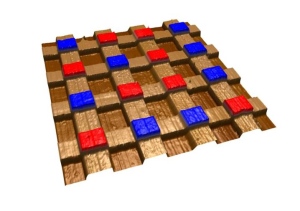New non-volatile ferroelectric memory with reading based on photoelectric effect
 We are all aware of almost the only drawback of modern fast RAM modules - volatility, in turn, for long-term drives, the speed of work leaves much to be desired. The prototype of the memory of a new type, described in Nature Communications, combines in itself both speed, non-wearability and low power consumption, and non-volatility.
We are all aware of almost the only drawback of modern fast RAM modules - volatility, in turn, for long-term drives, the speed of work leaves much to be desired. The prototype of the memory of a new type, described in Nature Communications, combines in itself both speed, non-wearability and low power consumption, and non-volatility.The new type of memory was built on the basis of bismuth ferrite by a material scientist at the University of California at Berkeley Ramamuroti Ramesh and a specialist in materials-oxides at Nanyang University of Technology in Singapore Yonglin Wang.
Regular zeros and bits of computer memory can be represented by bismuth ferrite as one of two polarization states. Switching between them is possible when voltage is applied due to the physical phenomenon of ferroelectricity. Ferroelectric RAM based on other materials is already on the market, and its speed is high. But the technology is not widely spread because the electrical signal used to read a bit resets it, so the data must be rewritten each time. In the future, this leads to a deterioration in reliability.
')
Ramesh and Van found a way to use one of the properties of bismuth ferrite to read arrays of memory without destroying information. In 2009, researchers at Rutgers University demonstrated that the material has photoelectric properties in the visible spectrum. This means that when the material is illuminated, an electrical voltage is created, the size of which also depends on the state of polarization. This voltage can be recorded, at the same time, bright light does not change the state of polarization of the material and does not reset the information recorded on it.
In the course of the study, experiments were carried out, during which the bismuth ferrite films were expanded on the metal oxide, then it was etched into four strips. Four metal stripes at certain angles were superimposed on top. 16 square areas in the places of contact behaved like memory cells, and metal and metal oxide formed their conclusions. With their help, the cells were polarized, then they were illuminated with light and two voltage values were recorded for zero and one.
Less than 10 nanoseconds are required for reading and writing, and writing requires 3 volts of voltage. For comparison: non-volatile RAM based on flash memory requires approximately 100 thousand times more time and requires 15 volts to write.
San Wuk Chun, who investigated this effect, called the results the first practical use of the 2009 discovery. However, Victor Zhirnov, a material scientist at Semiconductor Research Corporation (North Carolina), believes that technology will face significant minimization before real use and at least some competitiveness. Modern flash memory uses a process technology of 22 nm, and the prototype photoelectric memory has a width of 10 micrometers.
Ramesh believes that there are no principal obstacles to reducing to other types of memory cells, although there may be technological difficulties. You also have to develop miniature light guides to illuminate not the entire memory module, but only a part of it.
Based on Nature.com .
Report research on non-volatile memory (English, 2013).
Report on the study of the photoelectric properties of bismuth ferrite (English, 2009).
Source: https://habr.com/ru/post/183062/
All Articles